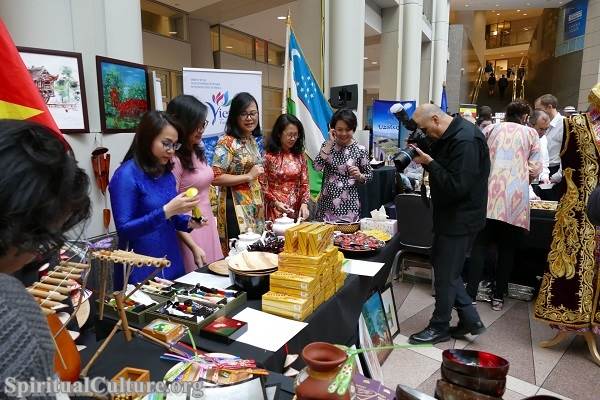The cuisine of the United Arab Emirates is a profoundly humanistic reflection of its history, a vibrant tapestry woven from Bedouin desert simplicity, the bounty of the Gulf’s maritime life, and the rich spices introduced by centuries of international trade. While modern UAE is known for global cosmopolitanism, its traditional foods—the bedrock of its identity—remain potent symbols of generosity, community, and ancestral resilience.
At Spiritual Culture, we believe that food is a sacred expression of culture, and Emirati dishes, in particular, serve as tangible links to the past. The slow-cooked preparations, the communal sharing, and the intentional use of aromatic spices (like cardamom and saffron) elevate a simple meal to a spiritual experience of belonging. These dishes are not merely sustenance; they are heirlooms of flavor, passed down through generations to preserve the soul of the nation.
Our ranking celebrates the dishes whose cultural impact, historical prominence, and role in religious and social gatherings cement them as the definitive Top 10 most famous Emirati foods. This list is based on reasoned cultural criteria, including UNESCO status, historical preparation methods, and continued centrality in local festive life as of the Current Time of Writing.
Table of the Top 10 Most Famous Emirati Foods and Their Cultural Significance
| Rank | Dish Name | Cultural Category | Primary Spiritual/Cultural Role | Key Ingredient/Distinguishing Feature |
|---|---|---|---|---|
| 1 | Harees | Ceremonial Main Dish | Symbol of Patience, Generosity, and Unity (UNESCO Intangible Heritage Status) | Slow-cooked crushed wheat and meat (lamb/chicken) |
| 2 | Luqaimat | Dessert/Treat | The Essential Iftar Sweet (Breaking the fast during Ramadan) | Deep-fried dough balls drenched in date syrup (Dibs) |
| 3 | Machboos (Majboos) | National Main Dish | Feast centerpiece for weddings and large community gatherings | Spiced rice cooked with meat, fish, or chicken and dried lime (Loomi) |
| 4 | Balaleet | Breakfast/Dessert | Traditional Eid Al-Fitr morning celebration dish | Sweetened vermicelli served with a saffron-cardamom omelet |
| 5 | Thareed | Ramadan Stew | Comfort food mentioned in Prophetic tradition, known for high nourishment | Meat/vegetable stew layered over thin, crispy Rigag bread |
| 6 | Gahwa & Dates | Hospitality Ritual | Fundamental gesture of welcoming guests and commencement of all social gatherings | Arabic coffee (Gahwa) infused with cardamom, served with fresh dates (Tamr) |
| 7 | Khuzi (Ghuzi) | Grand Feast Dish | Served at the largest, most significant banquets (e.g., weddings) | Whole slow-roasted lamb or goat served over spiced rice and nuts |
| 8 | Samak Mashwi | Coastal Staple | Reflects the ancient maritime heritage of the Gulf fishing communities | Fresh Gulf fish (like Hamour) marinated in Bezār spices and grilled |
| 9 | Madrouba | Comfort Dish | Easy-to-digest, nutrient-rich meal popular during winter and for the elderly/children | Creamy, beaten rice porridge with chicken or fish and warming spices |
| 10 | Chebab | Breakfast/Sweet Bread | Traditional, spiced Emirati pancake for morning meals and gatherings | Thin, saffron and cardamom-spiced pancakes served with date syrup or cheese |
Top 10 Most Famous Emirati Foods
Top 10. Chebab
Chebab, the Emirati version of a pancake, provides a beautiful, aromatic start to the day, often signaling a relaxed, traditional morning. Infused with the classic Emirati warming spices of cardamom and saffron, this thin, spongy bread is a quintessential expression of local culinary simplicity, traditionally cooked over a curved griddle. It represents the domestic heart of the Emirati home, where simple ingredients are transformed into a comforting, golden-hued staple.
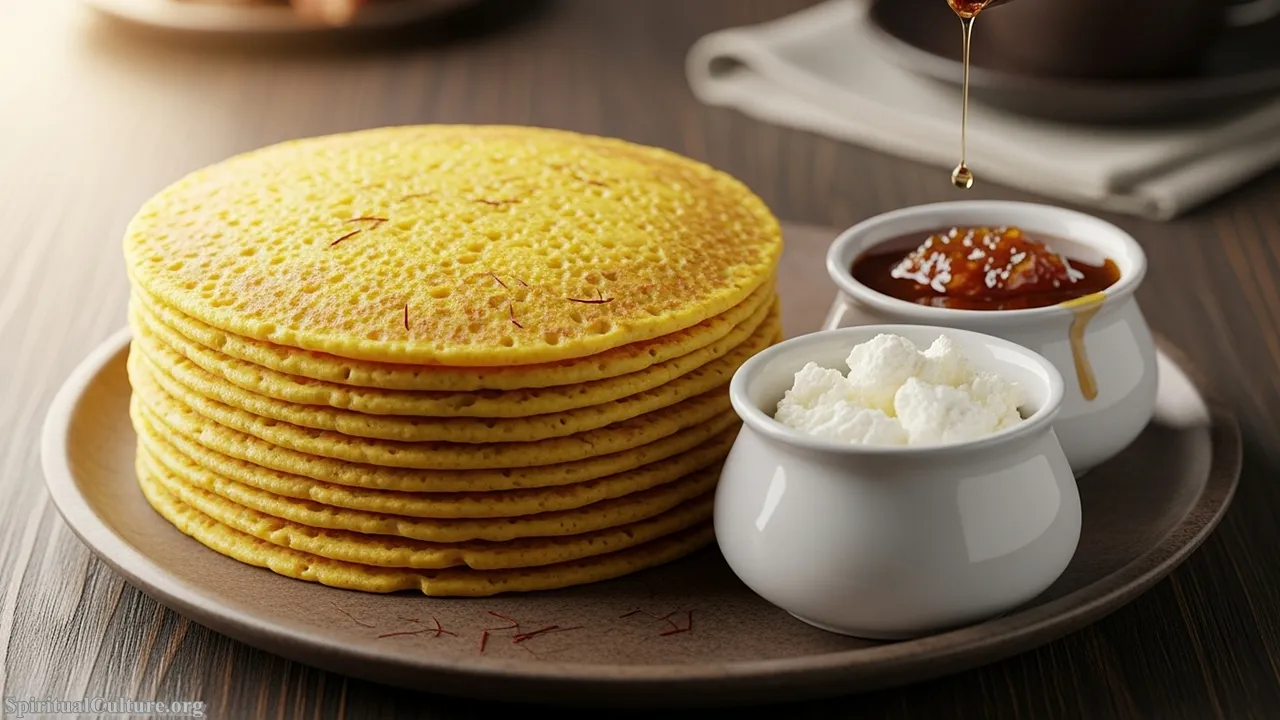
The light fermentation and distinctive golden color, derived from saffron and turmeric, bestow upon Chebab a warmth that is both physical and spiritual. Eaten with date syrup (Dibs) or a spread of cheese, it embodies the sweet and savory balance characteristic of Gulf breakfast traditions. This is the meal of shared conversations and quiet moments before the day’s work begins, cementing its role in the culture of family togetherness.
Preservation of Chebab’s simple recipe reinforces the value of culinary continuity in a rapidly modernizing nation. The skills involved in mixing the batter and achieving the perfect thinness are passed from mother to daughter, maintaining a tactile connection to the domestic practices of the ancestors. To share Chebab is to share a slice of authentic, unhurried Emirati morning life.
Cultural/Spiritual Highlights
- Uses Saffron, a spice historically associated with wealth and hospitality.
- Often served with date syrup (Dibs), linking it to the ancient date palm culture.
- A popular dish for Iftar during Ramadan, following the main meal.
Top 9. Madrouba
Madrouba, whose name literally translates to “beaten,” is a creamy, comforting rice and meat porridge that speaks directly to the Bedouin emphasis on resourcefulness and nourishment. The process of slow-cooking and beating the ingredients—often rice, fish (or chicken), and spices—into a smooth, thick consistency ensures maximum digestibility and flavor extraction. It is a hearty, medicinal dish, particularly valued for sustaining energy during the cooler winter months or for nurturing the very young and the elderly.
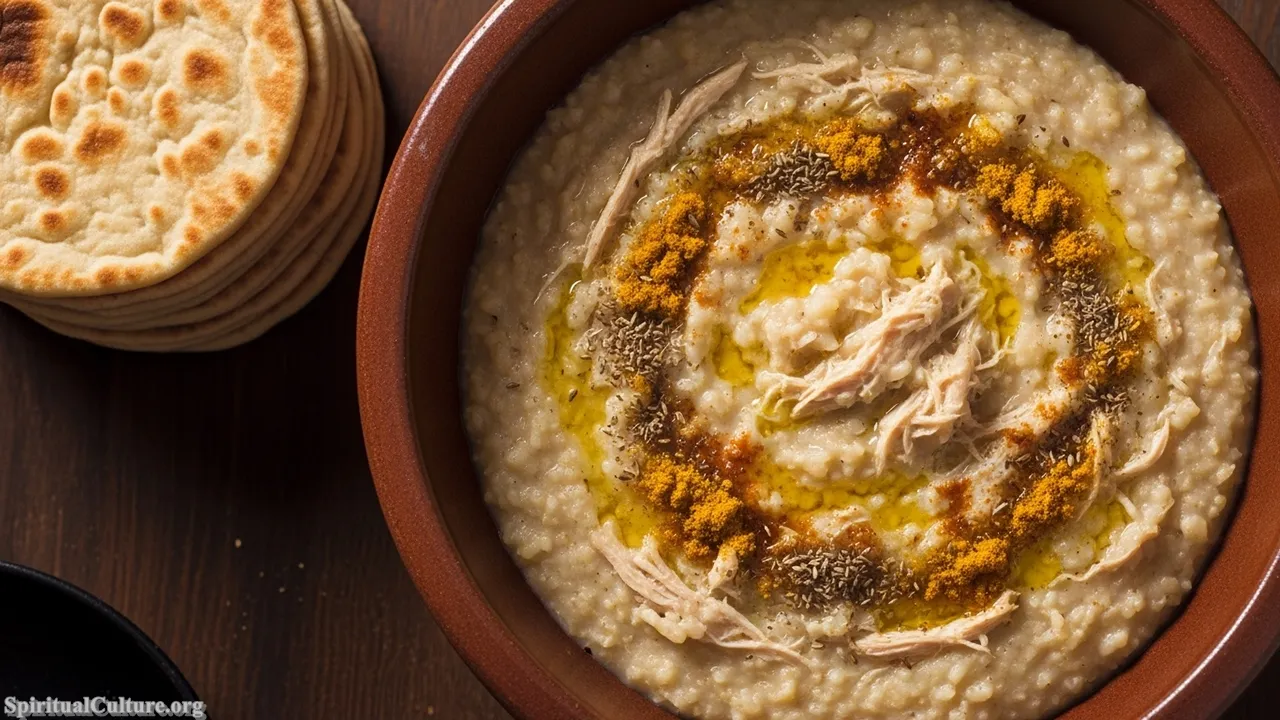
The spiritual impact of Madrouba lies in its expression of care and foundational nourishment. Its preparation is a labor of love, requiring patience to achieve the perfect, homogenous texture, symbolizing the community’s commitment to providing for all its members, regardless of age or physical condition. It is food as a benevolent act, transforming simple ingredients into a deeply satisfying, wholesome meal.
In reflecting on Madrouba, we observe the preservation value inherent in simplicity. It is a one-pot meal that minimizes waste and maximizes flavor, a vital lesson in sustainable living inherited from the desert dwellers. The tradition of consuming such a meal highlights the importance of collective well-being and the continuous cycle of community support.
Cultural/Spiritual Highlights
- The term Madrouba refers to the traditional preparation method of ‘beating’ the ingredients.
- A quintessential winter dish, valued for its warming and energy-sustaining properties.
- Primarily made using Hamour (Grouper) or other local Gulf fish, linking it to maritime heritage.
Top 8. Samak Mashwi
Samak Mashwi, or grilled fish, is a direct, elemental connection to the UAE’s millennia-long identity as a coastal and maritime power. Before the discovery of oil, the Gulf’s bounty—pearl diving and fishing—formed the economic and cultural backbone of the Trucial States. This dish honors that legacy, featuring locally caught fish marinated in a rich Bezār spice blend, a proprietary mix of spices that defines the Emirati flavor profile.
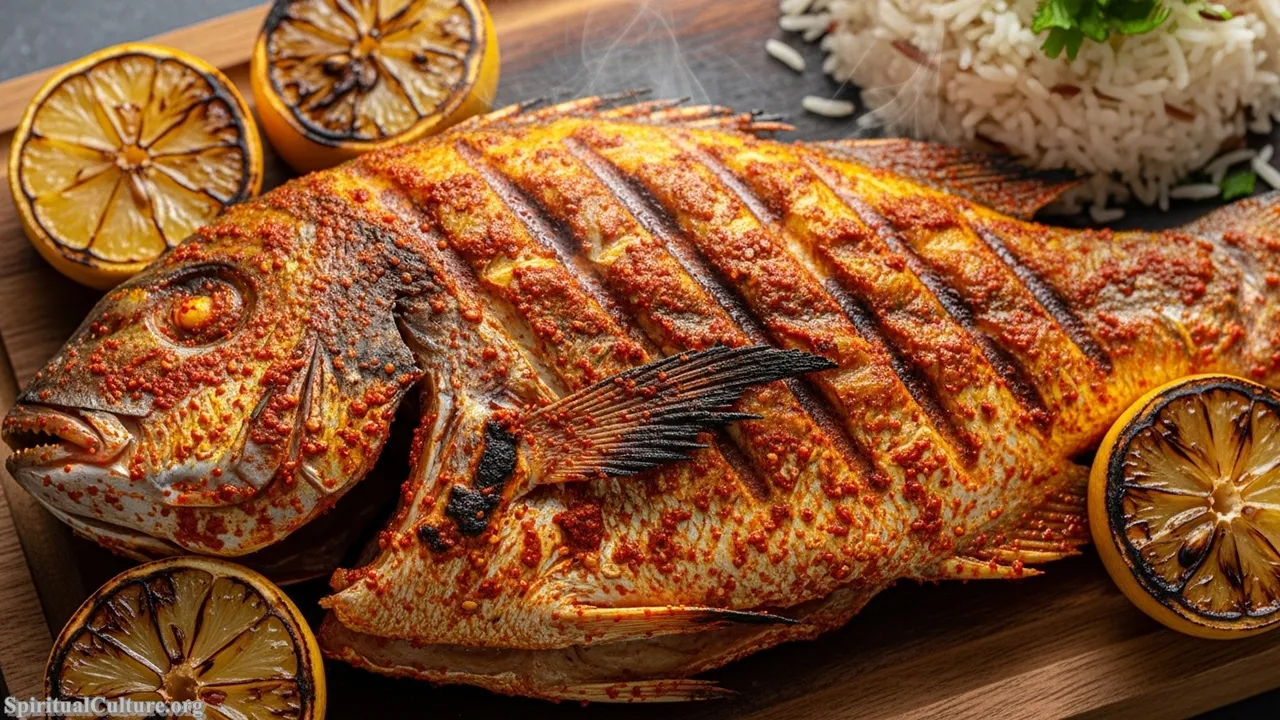
The spiritual impact is found in the reverence for the sea and its sustenance. Samak Mashwi is a celebration of the elemental provision from the Arabian Gulf, prepared with minimal complexity to honor the freshness of the catch. The act of grilling over a flame is an ancient practice, a ritual that connects the modern diner to the hardworking fishermen ancestors who relied entirely on the sea’s mercy and generosity.
The preservation of this dish is crucial for maintaining the intangible heritage of the UAE’s coastal regions. It is a flavorful reminder that Emirati culture is dual-faceted: desert-born and sea-nurtured. Its preparation, especially using the Bezār blend, protects and promotes the unique, regional spice taxonomy that sets Emirati cuisine apart from its neighbors.
Cultural/Spiritual Highlights
- The marinade uses Bezār, the essential, locally made Emirati spice mix (including turmeric, coriander, and chili).
- Represents the fishing communities and the vital role of the Gulf in historical livelihoods.
- Often cooked in a charcoal grill or underground pit for a distinct, smoky flavor.
Top 7. Khuzi (Ghuzi)
Khuzi (or Ghuzi) is the grand feast dish, instantly recognizable as a meal reserved for the highest echelons of celebration and generosity. It features a whole lamb or goat, slow-roasted to absolute tenderness, served majestically on a gargantuan platter of spiced rice, often topped with fried nuts, raisins, and vegetables. It is the culinary expression of excess and welcome, designed to be shared among dozens, if not hundreds, of guests.
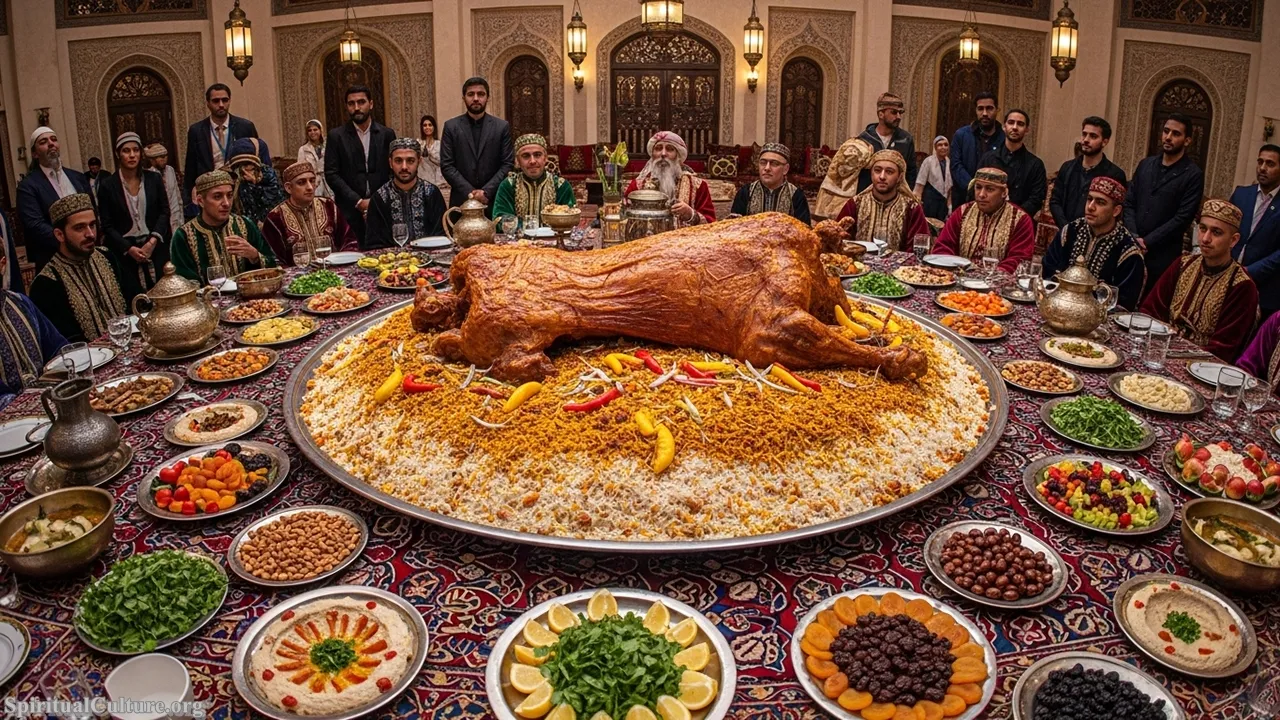
The reason for its ranking lies entirely in its role as a profound spiritual and social marker—it is the ultimate display of Arab hospitality (Diyafa). Khuzi is served at weddings, national holidays, and major gatherings, where the abundance and sheer scale of the dish communicate respect and honor for the guests. The grand spectacle of the whole roasted meat is a visible testament to the host’s wealth and open-handed spirit, a cardinal virtue in the Arab world.
The moral lesson of Khuzi is that the truest measure of a community is found in its celebrations. When such a massive undertaking of culinary effort is laid out, it underscores the value of sharing and the tradition of welcoming all who come to the door. It is a powerful cultural preservation tool, ensuring that the ancient Bedouin tradition of lavish, collective feasting remains central to contemporary Emirati life.
Cultural/Spiritual Highlights
- A primary dish for weddings and major national celebrations (like Eid).
- The act of serving a whole roast animal is the ultimate symbol of Diyafa (hospitality and generosity).
- Traditionally served on a large platter for communal, hand-fed eating.
Top 6. Gahwa & Dates
While technically a beverage and a fruit, Gahwa (Arabic coffee) and Dates (Tamr) together form the foundational ritual of all social and spiritual interactions in the UAE, making their combined presence one of the most famous and vital “foods.” They are the first items offered to any guest, irrespective of the time or occasion, serving as the cultural prelude to any conversation, negotiation, or gathering. The coffee, subtly infused with cardamom, is bitter, perfectly contrasted by the natural sweetness of the date.
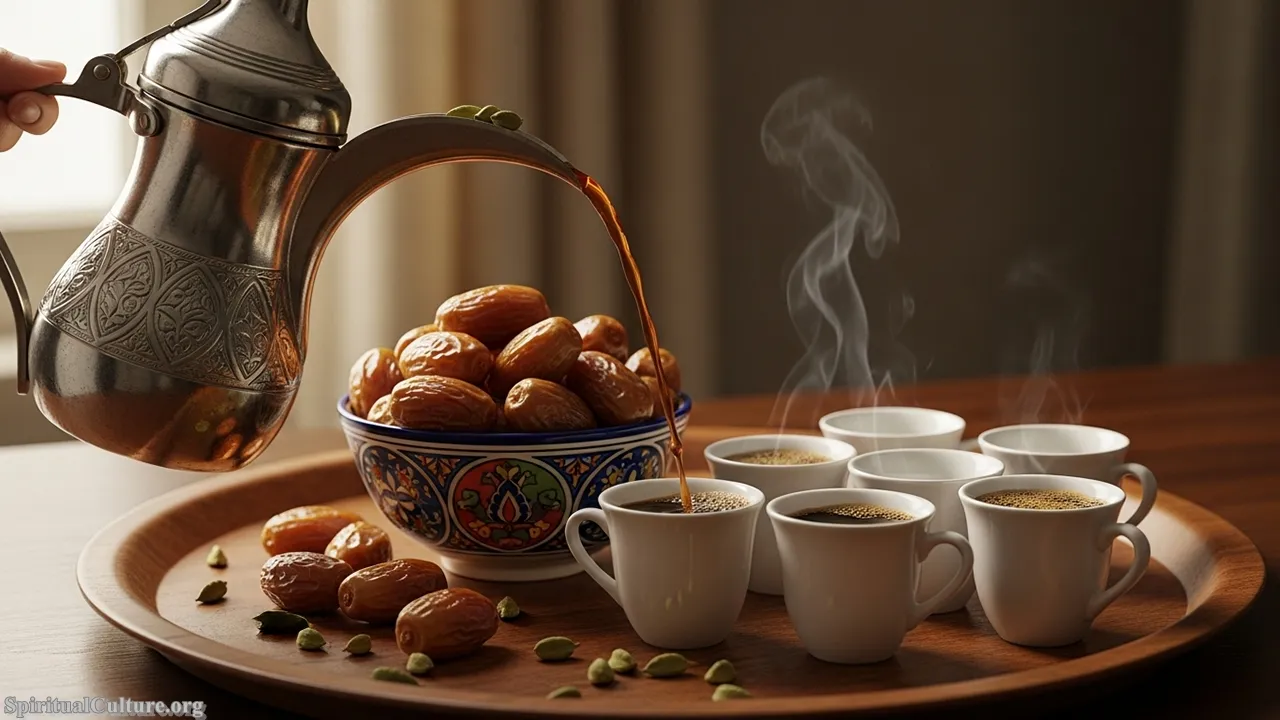
The spiritual impact of this pairing is paramount, acting as the covenant of Emirati hospitality. The bitterness of the Gahwa symbolizes the willingness to accept life’s hardships, while the date embodies the sweetness of its rewards and the host’s generosity. This ritual has been passed down for centuries, ensuring a continuous link to the Prophet Mohammed’s tradition of breaking the fast and receiving guests with these blessed items.
The preservation of this ritual is critical to the preservation of Emirati identity itself. The manner of serving—the small, handle-less cups (Finjans), the traditional pouring from the Dallah (coffee pot), and the offering of fresh dates from the palm—is a sacred code of conduct. It teaches patience, respect, and the profound importance of making the guest feel honored and welcome.
Cultural/Spiritual Highlights
- The essential opening ritual of Diyafa (hospitality) and social engagement.
- Dates are a Sunnah (Prophetic tradition) food for breaking the fast and a crucial desert staple.
- Arabic coffee is flavored with cardamom, signaling warmth and respect for the guest.
Top 5. Thareed
Thareed is not merely a dish but a living embodiment of historical and religious reverence, often referred to as the “Emirati Lasagna” due to its layered structure of rich stew and bread. It consists of a tender, slow-cooked meat and vegetable broth, poured over thin, crispy Emirati flatbread (Rigag). The bread soaks up the savory broth, transforming into a comforting, high-energy sponge of flavor, making it a staple of the Holy Month of Ramadan.

Its reason for ranking so highly is its specific connection to the spiritual realm: Thareed is famously reported to have been a favorite dish of the Prophet Mohammed, granting it an almost sacred status in Islamic culture. During Ramadan, its consumption is both a physical nourishment and a spiritual communion, as the dish provides sustained energy needed after the day’s fast. The slow-cooked meat symbolizes patience, while the breaking of the Rigag bread symbolizes the breaking of the fast and the joining of community.
The moral value of Thareed rests in its powerful example of humble abundance. Though its ingredients are simple, the resulting stew is complex and deeply satisfying. This dish encourages reflection on the sufficiency of simple blessings and the continuity of ancient traditions that hold deep meaning. It is a perfect illustration of how food can anchor both physical and spiritual strength.
Cultural/Spiritual Highlights
- Historically referenced as a dish favored by the Prophet Mohammed.
- A primary, nourishing dish for Iftar during the holy month of Ramadan.
- The Rigag (thin bread) soaks up the rich broth, representing spiritual absorption and sustenance.
Top 4. Balaleet
Balaleet secures a high rank as the sweet and savory herald of celebration, holding the definitive role as the traditional breakfast dish served immediately after the communal morning prayers on the first day of Eid Al-Fitr. This unique dish combines thin, sweetened vermicelli pasta, flavored with cardamom and saffron, and topped with a flat, savory egg omelet. It perfectly bridges the sweet-toothed celebrations with the need for a protein-rich morning meal.
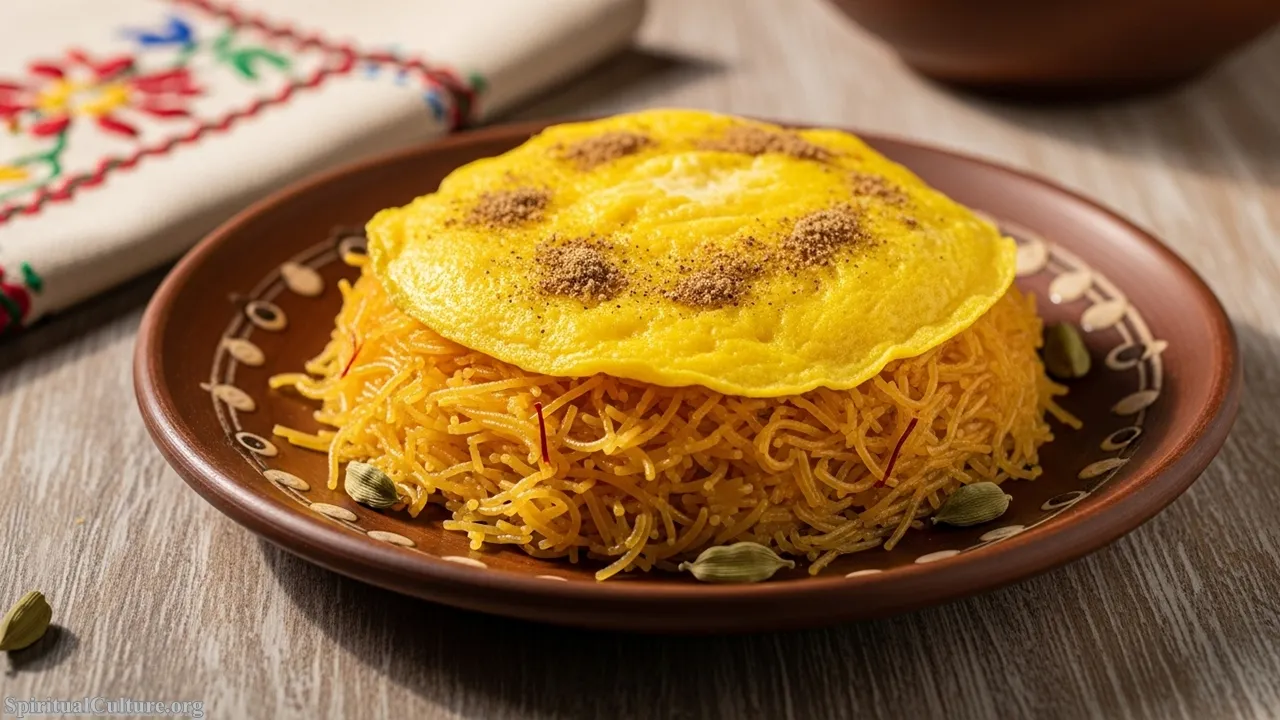
The spiritual and cultural significance of Balaleet is tied entirely to its festive role as a symbol of release and happiness after the spiritual exertion of Ramadan. The gold color of the saffron-infused vermicelli and the bright egg atop it represent the dawn of a new, joyous period. It embodies the concept of “balance” in life—a delicious juxtaposition of sweet celebration and savory grounding that reflects the dualities inherent in the cycle of spiritual effort and reward.
Preserving the tradition of Balaleet is preserving the identity of the Emirati holiday experience. It ensures that the end of Ramadan is marked by a distinctive, deeply rooted culinary symbol. The skill in balancing the sweetness of the vermicelli against the subtle saltiness of the omelet is a micro-lesson in cultural harmony, showing how different elements can coexist to create a whole that is greater than the sum of its parts.
Cultural/Spiritual Highlights
- The Essential breakfast dish served on the morning of Eid Al-Fitr.
- The sweet-and-savory contrast symbolizes balance and the joy of breaking the long fast.
- Infused with saffron and cardamom, two of the most prized and traditional Emirati spices.
Top 3. Machboos (Majboos)
Machboos is arguably the national dish of the UAE, and its place at the top of the cultural hierarchy is non-negotiable, serving as the quintessential culinary centerpiece for virtually any important gathering. Aromatic, spiced rice is cooked with meat (lamb, chicken, or fish) in a broth infused with traditional Gulf spices and, most importantly, Loomi—dried black lime—which imparts a signature tangy and complex flavor profile. It is a culinary metaphor for the nation’s history as a crossroads of the spice trade.
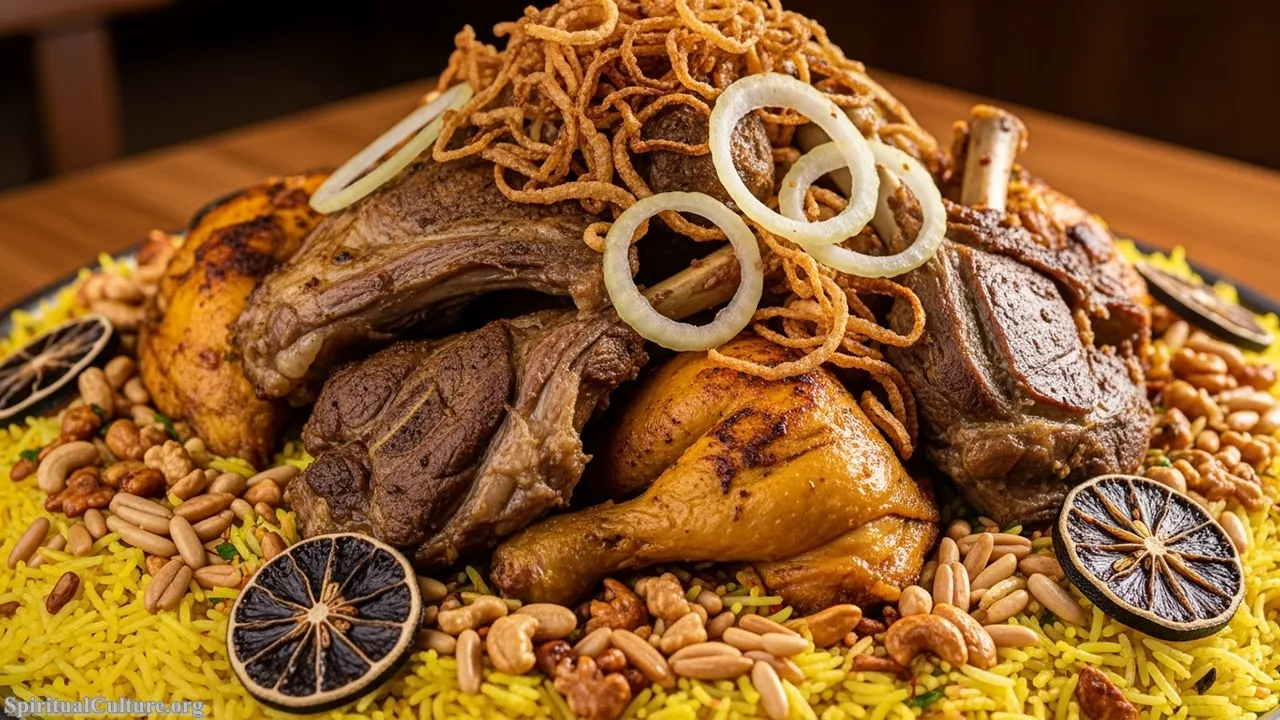
The reason for its high ranking is its absolute centrality to family and communal life; it is the dish of unity. Machboos is prepared in large quantities and served on shared platters, encouraging guests to eat together and fostering a palpable atmosphere of connection. The meticulous layering of spices, rice, and meat represents the rich, multi-layered history of the Emirates, blending the simplicity of local ingredients with the complexity of imported flavors.
The moral significance of Machboos lies in its teaching of generosity and community. To prepare a Machboos feast is to invite and honor. Its enduring popularity reinforces the cultural value that the most memorable moments are those shared at a communal table. The fragrant aroma of the Loomi and spices, instantly recognizable, is the smell of home, heritage, and the soul of the UAE.
Cultural/Spiritual Highlights
- Often cited as the National Dish of the UAE and the Gulf region.
- The inclusion of Loomi (dried black lime) is a defining and distinctive flavor marker of Gulf cuisine.
- The cornerstone dish of family gatherings, Iftar meals, and major social events.
Top 2. Luqaimat
Luqaimat, translating to “small bites,” are small, deep-fried dumplings whose texture is crispy on the outside and wonderfully light and airy on the inside, drizzled generously with local date syrup (Dibs). They are the definitive Emirati dessert, found at every festival, celebration, and, most importantly, at every Iftar table during Ramadan.
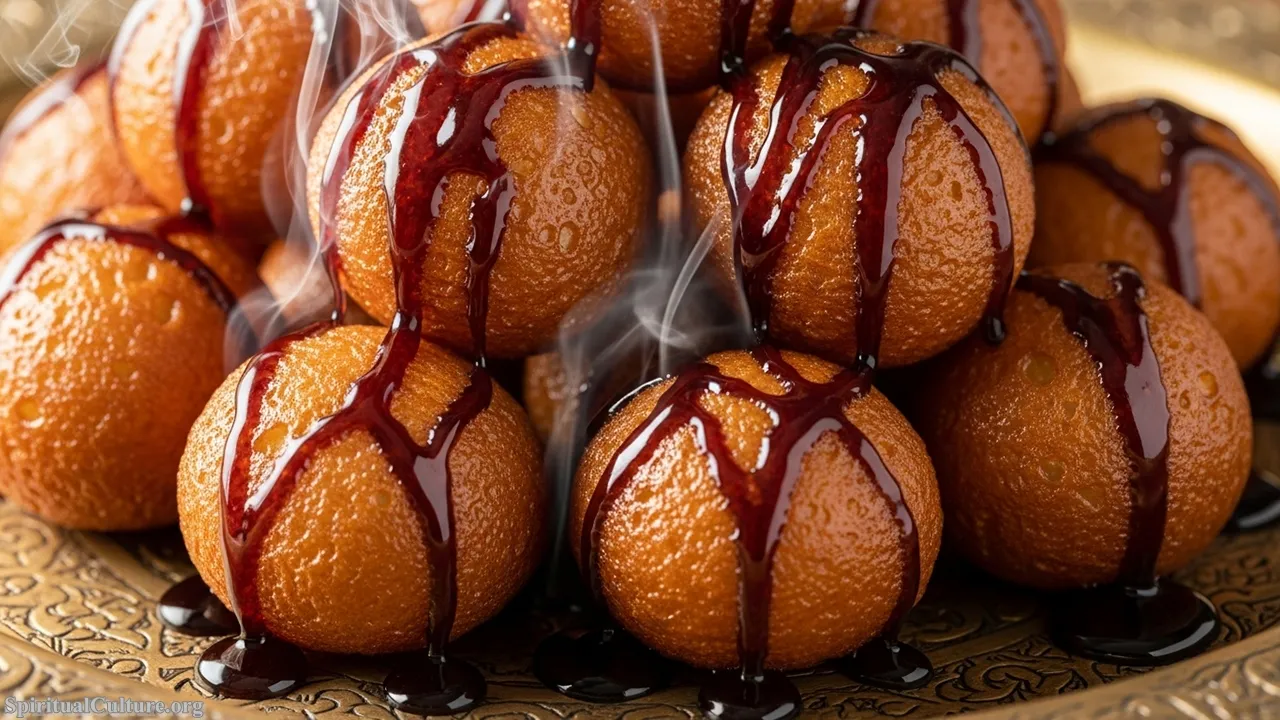
Luqaimat ranks highly because of its singular spiritual association with the Holy Month. These golden, sweet spheres are the essential taste of the reward after the day’s fast. As the most famous and beloved Emirati sweet treat, they symbolize the sweetness of breaking the fast, the ease of sustenance after hardship, and the joy of community reunion. Their preparation is a time-honored, festive ritual that transforms simple dough into a decadent sign of abundance.
The reflection on Luqaimat encourages us to appreciate the concept of immediate, simple pleasure as a spiritual gift. The warmth of the freshly fried dough and the viscous sweetness of the date syrup embody the generosity of the earth and the importance of indulging in life’s simple, traditional joys. They are a universal language of celebration, deeply ingrained in the nation’s culinary memory.
Cultural/Spiritual Highlights
- The Essential sweet for Iftar during Ramadan and all major festivals.
- Often flavored with saffron and cardamom in the dough, tying them to core Emirati spices.
- Drizzled with Dibs (date syrup) rather than honey, emphasizing the indigenous date palm heritage.
Top 1. Harees
Harees ascends to the pinnacle of this list not just for its popularity, but for its official recognition and deep-seated cultural symbolism, cementing it as the most spiritually and culturally significant Emirati food. Made from crushed wheat and meat (typically lamb or chicken), slow-cooked for many hours until the mixture achieves a smooth, porridge-like consistency, it is a dish of elegant simplicity, often served with a drizzle of clarified butter (ghee).

The definitive reason for its number one ranking is its recent inscription on the UNESCO Representative List of the Intangible Cultural Heritage of Humanity (as of the Current Time of Writing). Harees symbolizes patience, as its preparation requires meticulous, time-consuming effort, and unparalleled generosity, as it is traditionally prepared in massive batches for weddings, national holidays, and, most notably, during the holy month of Ramadan. It is the food of the blessed occasion, signifying unity and community endurance.
The enduring preservation of Harees’s complex, slow method of preparation is a moral beacon for the nation, valuing process, heritage, and communal effort over modern speed and convenience. The dish teaches that the greatest rewards often require the deepest commitment. Harees is the consummate expression of the Emirati soul: simple in essence, rich in meaning, and profoundly dedicated to the spirit of sharing.
Cultural/Spiritual Highlights
- Inscribed on the UNESCO Representative List of the Intangible Cultural Heritage of Humanity.
- A primary ceremonial dish for weddings, national holidays, and Ramadan.
- Symbolizes patience, as it is slow-cooked for up to seven hours until perfectly smooth.
- The act of sharing it reinforces community bonds and hospitality.
Conclusion
The traditional foods of the United Arab Emirates are far more than recipes; they are historical records and living expressions of a spiritual and cultural legacy defined by resilience, generosity, and an intimate connection to the land and sea. From the profound, communal patience embodied by Harees to the celebratory sweetness of Luqaimat, each dish is a masterclass in transforming the humble staples of desert life—dates, wheat, and spices—into feasts fit for a king. At Spiritual Culture, we celebrate this cuisine as a powerful, ongoing narrative of heritage, a delicious testament to the spirit of a people who honor their past even as they build the future. This culinary tradition invites the world not just to eat, but to experience the profound warmth of the Emirati heart.




